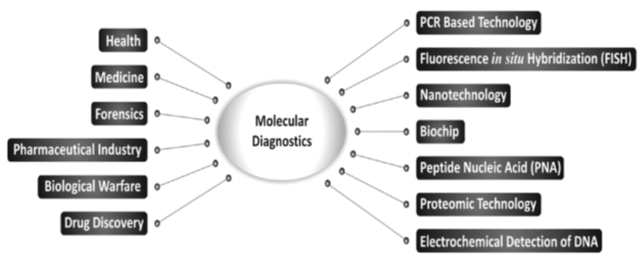
The application of molecular technology in medicine is almost endless, some of the applications of molecular methods are:
- Classification of organism based on genetic relatedness (genotyping)
- Identification and confirmation of isolate obtained from culture
- Early detection of pathogens in clinical specimen
- Rapid detection of antibiotic resistance
- Detection of mutations
- Differentiation of toxigenic from non-toxigenic strains
- Detection of microorganisms that lose viability during transport, impossible, dangerous and costly to culture, grow slowly or present in extremely small numbers in clinical specimen
- Apart from their role in microbiology, these techniques can also be used in identifying abnormalities in human and forensic medicine
The main objectives of molecular diagnostics are:
- To identify viable technology drivers through a comprehensive look at platform technologies for molecular diagnostics, including probe-based nucleic acid assays, microarrays and sequencing;
- To discover feasible market opportunities by identifying high-growth applications in different clinical diagnostic areas and by focusing on expanding markets, such as communicable diseases, cardiology and oncology; and
- To focus on global industry development through an in-depth analysis of the major world markets for molecular diagnostics, including growth forecasts
There are approximately five to six areas of molecular diagnostics carried out by hospitals, reference laboratories, and research institutes:
Infectious diseases molecular testing
This involves the design of DNA probes that are directed against the specific sequences of viruses, bacteria, or parasites.
Molecular oncology testing.
This looks at individual cancer markers and involves detecting any derangements or alterations in either the DNA sequence or gene expression that could be found in a tumor and nowhere else in the body.
Inherited diseases molecular testing.
This looks at inherited disease (genetic diseases) where one should be able to locate mutations in the body inherited from the parents (parent).
Identity testing — DNA fingerprinting.
This looks at benign variations in DNA sequences that exist between people in a population and has many applications, such as, forensic testing to solve crimes, paternity testing, monitoring bone marrow transplants as it can be used to distinguish donor from recipient cells.
Tissue type testing — HLA (Human Leukocyte Antigen) typing or histocompatibility testing
This is a blood test that measures substances called antigens on the surface of body cells and tissues. Checking the antigens can tell if donor tissue is safe (compatible) for transplant to another person. In some cases, a tissue type test may be done to see whether a person has a chance for developing certain diseases that cause the body to attack its own cells, such autoimmune diseases.
Pharmacogenomics testing.
This is probably the newest area which looks at benign variants in the human genome in genes that are involved in drug metabolism and alter subtly how a drug is metabolised. Such tests will be useful prior to initiation of therapy in order to choose the best or most appropriate therapy for the patient. This is one key technologies in what is popularly referred to as “personalized medicine”